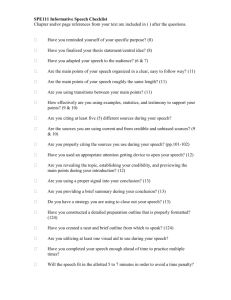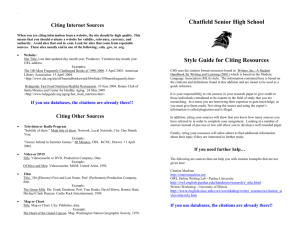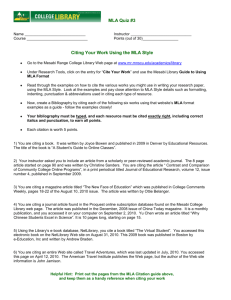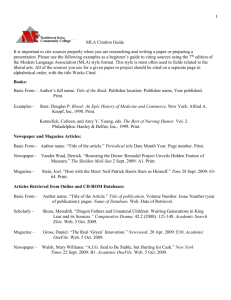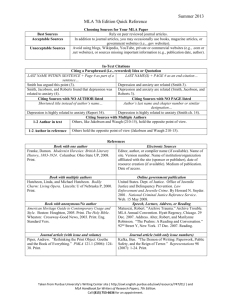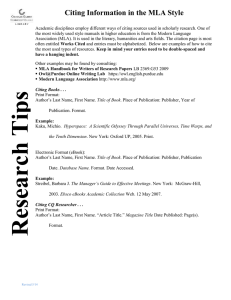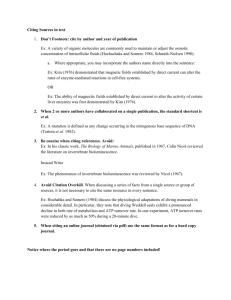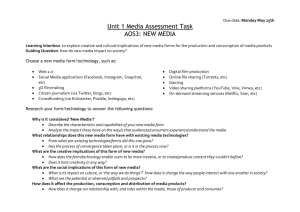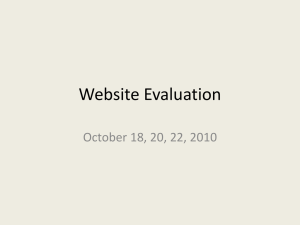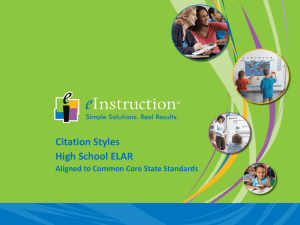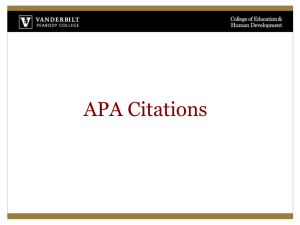Citing Sources MLA
advertisement
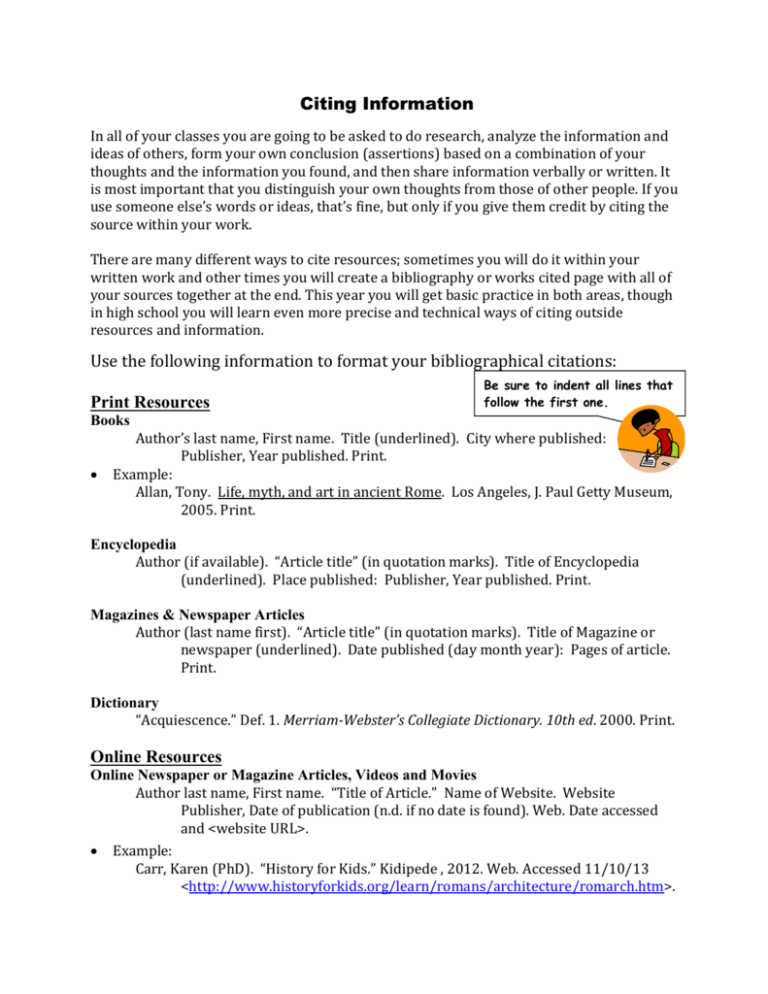
Citing Information In all of your classes you are going to be asked to do research, analyze the information and ideas of others, form your own conclusion (assertions) based on a combination of your thoughts and the information you found, and then share information verbally or written. It is most important that you distinguish your own thoughts from those of other people. If you use someone else’s words or ideas, that’s fine, but only if you give them credit by citing the source within your work. There are many different ways to cite resources; sometimes you will do it within your written work and other times you will create a bibliography or works cited page with all of your sources together at the end. This year you will get basic practice in both areas, though in high school you will learn even more precise and technical ways of citing outside resources and information. Use the following information to format your bibliographical citations: Print Resources Be sure to indent all lines that follow the first one. Books Author’s last name, First name. Title (underlined). City where published: Publisher, Year published. Print. Example: Allan, Tony. Life, myth, and art in ancient Rome. Los Angeles, J. Paul Getty Museum, 2005. Print. Encyclopedia Author (if available). “Article title” (in quotation marks). Title of Encyclopedia (underlined). Place published: Publisher, Year published. Print. Magazines & Newspaper Articles Author (last name first). “Article title” (in quotation marks). Title of Magazine or newspaper (underlined). Date published (day month year): Pages of article. Print. Dictionary “Acquiescence.” Def. 1. Merriam-Webster’s Collegiate Dictionary. 10th ed. 2000. Print. Online Resources Online Newspaper or Magazine Articles, Videos and Movies Author last name, First name. “Title of Article.” Name of Website. Website Publisher, Date of publication (n.d. if no date is found). Web. Date accessed and <website URL>. Example: Carr, Karen (PhD). “History for Kids.” Kidipede , 2012. Web. Accessed 11/10/13 <http://www.historyforkids.org/learn/romans/architecture/romarch.htm>. Online Dictionary Author Last, First M. "Entry Name." Definition Number. Website Title. Publisher or Sponsor, Date Month Year Published. Web. Date Mon. Year Accessed. <Url> Example: “Acquiescence.” Def. 1. Merriam-Webster.com, Merriam Webster, n.d. Web. 17 Mar 2013. <http://www.merriamwebster.com/dictionary/acquiescence> Other important things to know Sources should be listed alphabetically (by author). If no author, include by title. If there is an editor instead of an author, include the editor’s last name, then the first name followed by a comma and the abbreviation ed., an abbreviation for editor. If there are two authors, list the first one as last name, first name but then the second one first name (no comma) last name. If there are multiple authors (three or more), list the first one alphabetically by last name followed by the abbreviation et al., a Latin abbreviation for “and others.” How to Cite a Website & Other Web Resources - MLA Format General Structure for MOST ENTRIES: Last name, First name. "Article Title." Website Title. Publisher of Website, Day Month Year article was published. Web. Day Month Year article was accessed. <URL>. Example: Cain, Kevin. "The Negative Effects of Facebook on Communication." Social Media Today RSS N.p., 29 June 2012. Web. 02 Jan. 2013. Make sure to: Indent every line after the first line of your entry. To do this on a computer, just go to the beginning of the second line and press ENTER once and then for additional lines of the same entry just press TAB. Abbreviate the month of the date you accessed the site except for the following months: May, June, and July. Italicize the title of the Website. If you have more than one entry/source, alphabetize the entries by author last names. If you cannot find a place, publisher or date - use the place holders "N.p., n.p., n.d." (as needed) which represents no place, no publisher, and no date. Can’t find a piece of information you’re supposed to include? Just leave it out. If you need help formatting your bibliography you can visit some of these websites (choose MLA format): o http://www.easybib.com/reference/guide/mla/general o https://owl.english.purdue.edu/owl/resource/747/08/ o https://owl.english.purdue.edu/owl/resource/747/01/ Helpful to format typed essays. Citing a Book Originally in Print Found Online-----------------------------------Example: Catton, Bruce. The Civil War. Boston: Houghton Mifflin Co., 2005. Google Book Search. Web. 15 May 2008. Citing a Newsletter Found Online With No Page Information-------------------Example: Puzzanchera, Charles. "Juvenile Arrests 2007." Juvenile Justice Bulletin. (Apr.2009): n.pag. National Criminal Justice Reference Service. Web. 8 May 2009. Citing a Video Found Online---------------------------------------------------------Example: West, Kanye. Amazing. Prod. Hype Williams. Roc-A-Fella Records, 2009. Youtube Web. 8 Feb. 2009. Example: Picasso, Pablo. Three Musicians. 1921. ArtQuotes.net Web. 5 Apr. 2006. Citing a Musical Recording Listened to Online------------------------------------Example: Park, Obadiah. "Hey Ya." N.d. TheSixtyOne.com Web. 10 Feb. 2007. Citing a Digital Image Found on Google Images----------------------------------Example: Bruce Springsteen. Digital Image. Google Images. LIFE. Web. 9 Oct. 2009. <http://images.google.com>. Note: In the above example the title is not in quotes because it is a description of the digital image. The URL was truncated to the search URL because it was too long and complicated. Citing an Originally in Print Journal Article Found in a Database--------------Example: Ahn, Hyunchul, and Kyoung-jae Kim. "Using Genetic Algorithms to Optimize Nearest Neighbors for Data Mining." Annals of Operations Research 263.1 (2008): 5-18. Academic Search Premier. Web. 25 Sept. 2008. The above examples were complied from my own knowledge, MLA 7th edition website, the Easybib, and Pudue University’s Online Writing Lab (OWL).
